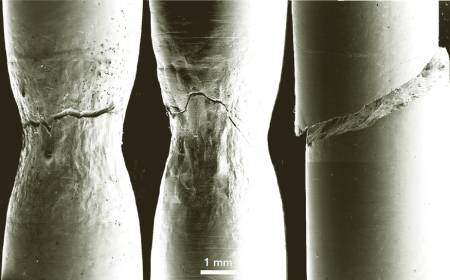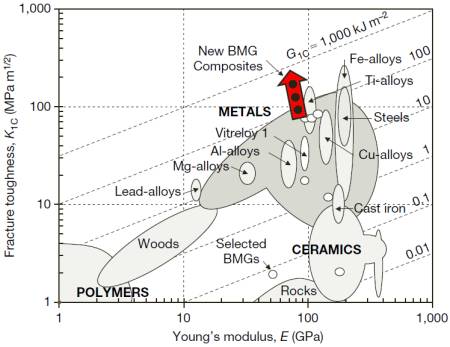
Researchers in the US have developed a class of materials that have the potential to be tougher than the best titanium or steel alloys, ranking them among the toughest known.
Bulk metallic glasses (BMGs) have shown promise in engineering for the past 15 years but have been let down by poor ductility, making them brittle and prone to fracture. But Douglas Hofmann, William Johnson and colleagues from the California Institute of Technology in Pasadena have found a way of modifying the structure of BMGs so that their ductility increases significantly.
BMGs are like metals in that they contain metallic bonds and conduct, yet their atoms are disordered like glass. A disordered structure cannot contain defects, which means that BMGs should withstand high loads before fracturing. This is as least true when they are bent or compressed, but when they are pulled their poor ductility fails them — parts of the materials begin to slide past each other in “shear bands”, which grow quickly into cracks.
One way of improving ductility and avoiding cracks, which has been adopted by the California team, is to introduce elements in the hot, initial BMG alloy that will nucleate dispersed crystals or “dendrites” when finally cooled. These dendrites act as a barrier to growing shear bands, preventing them from every developing into cracks. Instead, pulling the composite BMG will simply produce more, small shear bands, allowing the material to stretch and withstand a greater load.
We’ve taken alloys that are among the most brittle metals and made them among the toughest Douglas Hofmann, California Institute of Technology in Pasadena
The right dendrites
The idea of incorporating dendrites was first tried back in 2001 by Johnson with different group members, who cooled a BMG alloy from the molten state. This produced relatively small dendrites, and only increased the ductility marginally. Since studying those initial results, however, Hofmann, Johnson and colleagues have found two properties of the dendrites that will optimize ductility: they must be as large as the maximum length of the shear bands, and they must be softer than the BMG itself (Nature 451 1085).
To get such properties, they start with alloys of titanium, zirconium, niobium, copper and beryllium. By holding the alloys molten at a temperature between 800 and 900 °C, dendrites of titanium, zirconium and niobium can grow to a large size. As these grow, the relative proportion of beryllium and copper in the remainder of the bulk, which cannot form crystals, increases. The Californian team found that when the proportion of beryllium in the bulk reaches about a third, the composite reaches equilibrium, and the dendrites no longer grow. So by adding less beryllium to the initial alloy they can get less of the glassy phase and bigger dendrites. “We found this to be quite remarkable,” says Hofmann.
Out of three cooled BMG ingots with different amounts of dendrites, Hofmann, Johnson and colleagues found that the ingot with the highest proportion of dendrites (67%) demonstrated the greatest fracture toughness, K, at 173 MPa m1/2 — comparable with those of the best titanium, iron and steel alloys. However, their values for strength — defined by a high shear modulus, G — set new benchmarks (see fig: Ashby map for composite BMGs). “We’ve taken alloys that are among the most brittle metals and made them among the toughest,” says Hofmann.
Hofmann explains that although BMGs are primarily used for cosmetics at the moment, his group would like to exploit their new-found toughness in structural applications, for example in the aerospace industry. “We are hoping to acquire some of the market for high-performance titanium alloys,” he adds.




